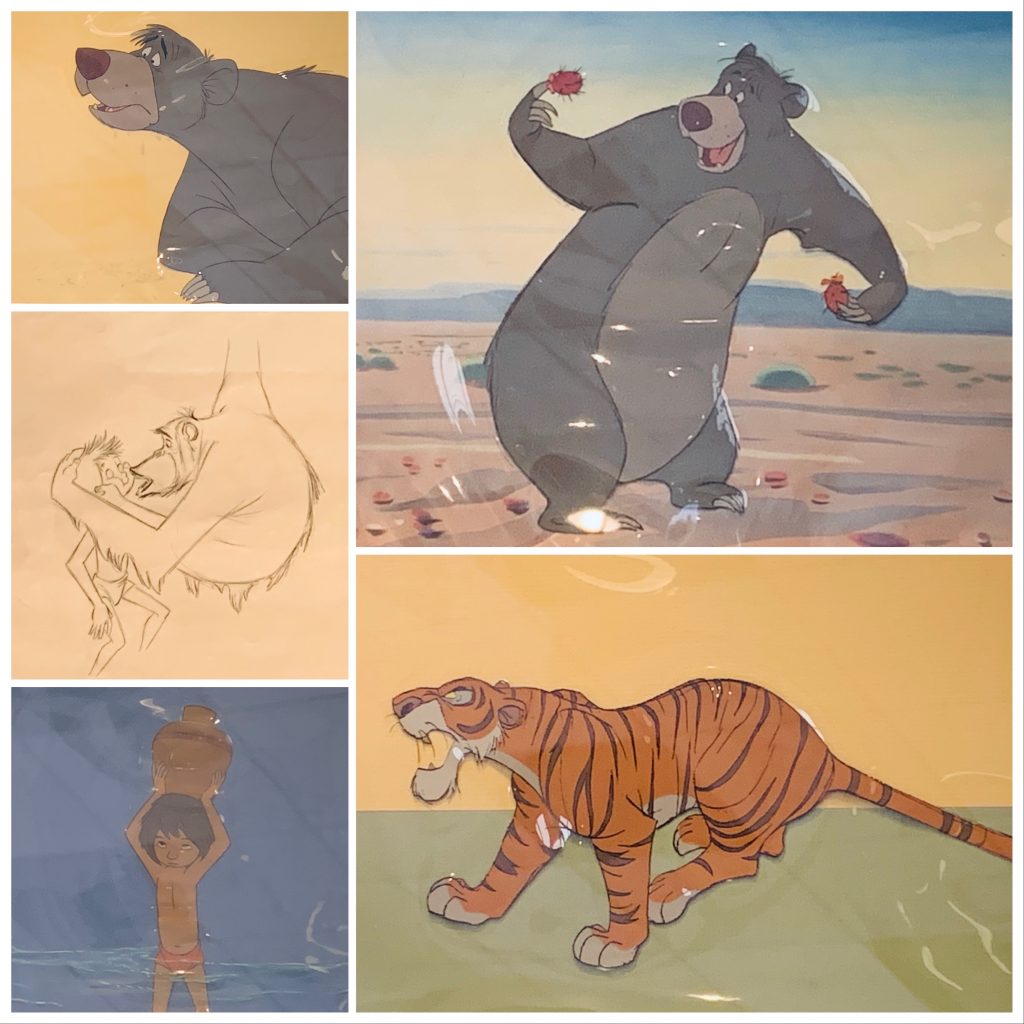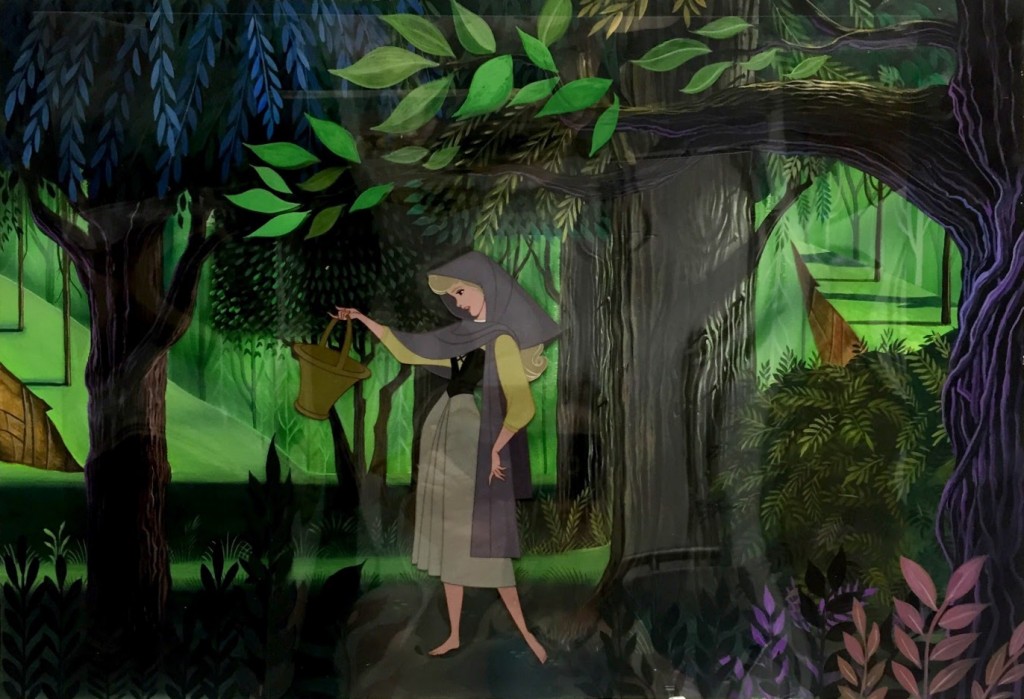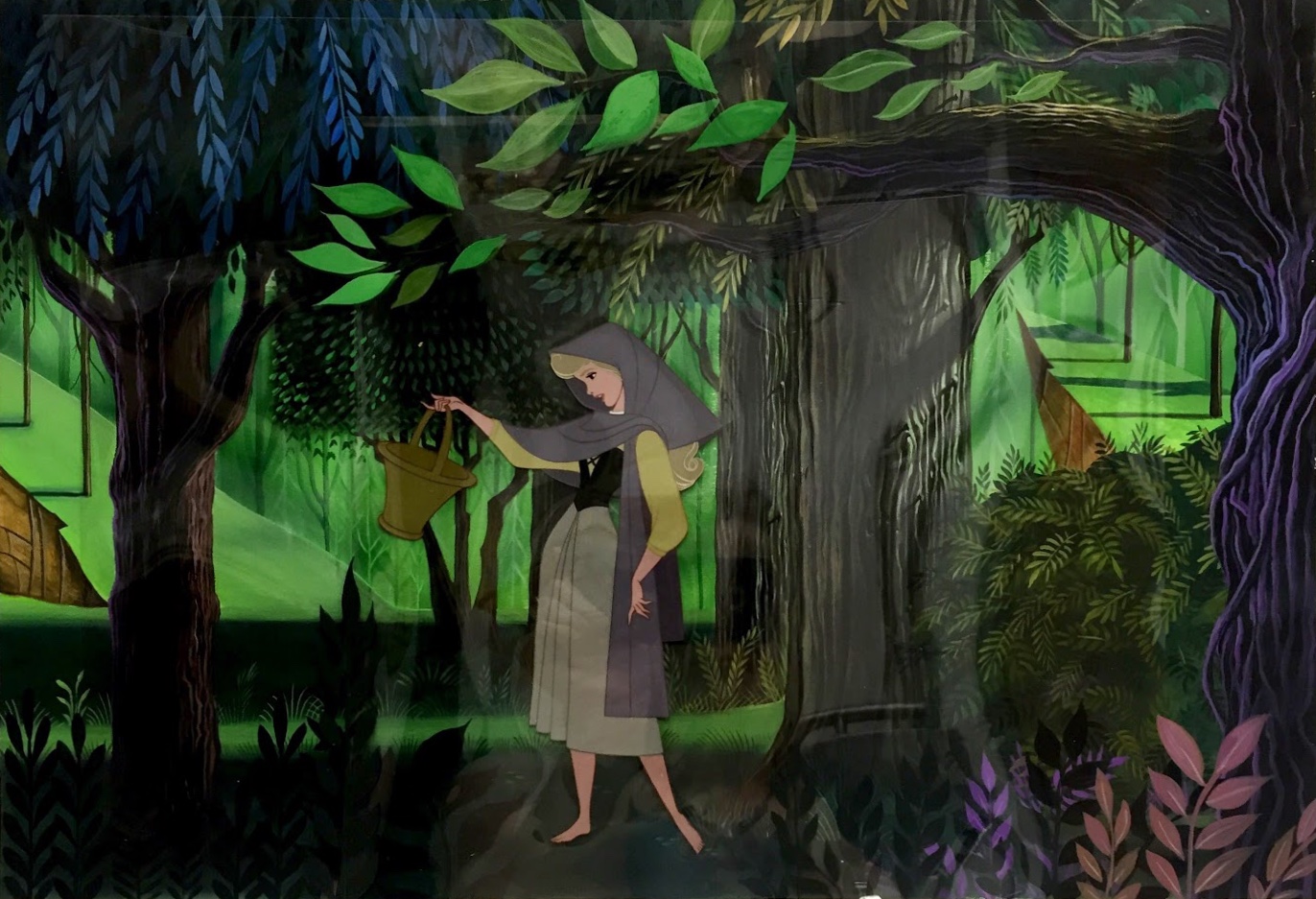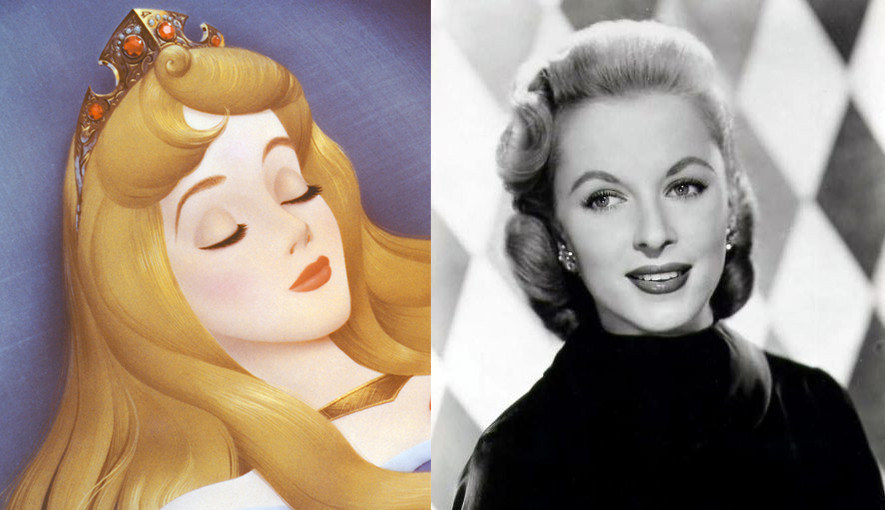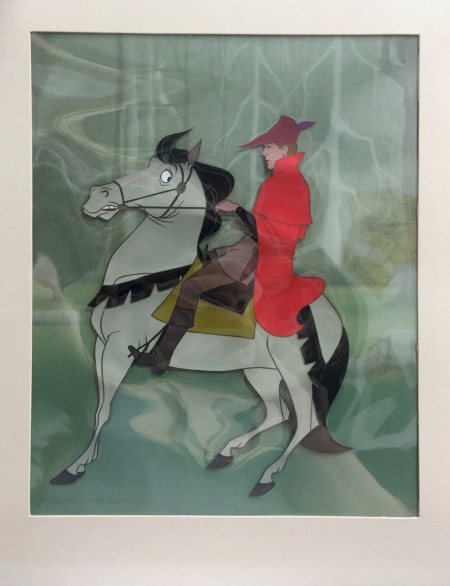The Jungle Book was my gateway drug into the addictive world of Disney feature films. I had always been a movie geek, from the first time I can remember watching a movie. As a Gen X baby, I was generally unsupervised in my viewing, often to my detriment, but I was also a very stubborn child, so if one of the actors I loved was featured in a film, I’d watch it no matter what the subject matter. Starting at the tender age of 5 or 6, I accrued a number of early and persistent favorites. Watching Paul Newman and Robert Redford in Butch Cassidy and the Sundance Kid taught me, even at 6, that I very much liked boys. Gene Kelly and his physical style of dance taught me that too, I I fell for him when I watched Cover Girl, but not nearly as hard as I did for Eve Arden. She taught me being a wise cracking dame was an option. Sidney Poitier was just grace personified, and super cool in my introduction to him in To Sir With Love. Roman Holiday brought Audrey Hepburn and Gregory Peck into my life, but then I watched Wait Until Dark to see Audrey again, and it scared the bejeezus out of me. One of the weirder crushes of my 6 year old self was on George Sanders. He played Simon Templar in 4 or 5 The Saint movies I watched over a period of only a few days. I mean..the accent! His suits! His savoir faire!
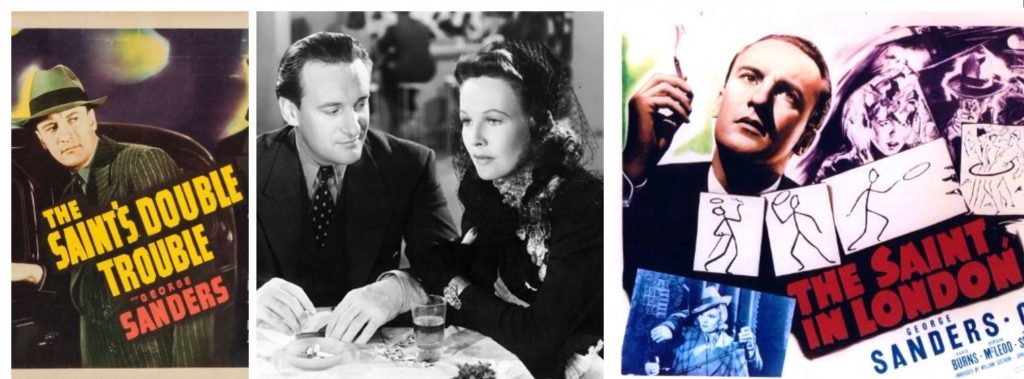
I watched Wile E Coyote and Road Runner and Bugs shorts from infancy, but how many animated features did I watch as a young child? Probably none. Honestly I don’t remember any before I saw The Jungle Book at age 8. I had recently been accidentally introduced to the horror genre when my oldest sister Pam was babysitting me and had friends over to watch The Night of the Living Dead. I’m pretty sure that’s the same weekend I saw the a French adaptation of Murders in the Rue Morgue. I have vivid memories of this black and white scene of a detective finding a woman stuffed up a chimney. I. WAS. SEVEN. Needless to say, I was primed for some more positive, joyful cinematic fare. It came in the form of the newest movie I found that featured George Sanders. Jungle Book not only had him, it had JAZZ!
Along with being a little kid that loved movies, I was also obsessed with jazz. I don’t remember how or when I saw the trailer for The Jungle Book, but it really sold the jazz element of the movie.
Since my first record was by Louie Armstrong, and my second was an Ella Fitzgerald album, I was all in when it came to that musical genre. So here was a movie that not only had George Sanders, one of my favorite actors, who I’d seen at this point playing villains in Rebecca and The Ghost and Mrs. Muir, but it had The King of Swing, Louie Prima! Interestingly, Disney’s original choice to play King Louie was Louis Armstrong. Wiser heads prevailed, (since a Black performer playing the King of the Monkeys would have rightly been seen as..uhh..problematic?) and Prima does a wonderful job.
Basically, The Jungle Book gave me a bit of a respite from what I thought were permanent night terrors and dreams of zombies twirling intestines. I wanted more, and that led me to watching all the Disney movies I could find. I must have seen The Jungle Book on a military base, because I saw it in English. The first time I saw Cinderella and The Aristocats, they were in French. All I know is The Jungle Book opened up a whole new world of film for me, one where there were no spilled guts, and happy endings were a given.
There’s something about The Jungle Book though that has always stuck with me in a way none of the other Disney movies could. I know they say you always remember your first, but it’s more than that. The Jungle Book is about friendship and sharing joy in music and caring for each other.
As an adult, I’m aware one can definitely rip the movie apart for its connection to Rudyard Kipling, the book’s original author. He was the colonialist and racist who wrote the poem “The White Man’s Burden” in 1899, in which he encouraged the American annexation of the Philippine Islands. Interestingly though, Kipling began writing The Jungle Book while living in the US. Though it takes place in the jungles of India, it was in part inspired by the wilderness of Vermont, and had as one of its themes the personal growth through adventures in the wild. That aspect of the story led to a friendship between Kipling and Theodore Roosevelt, then a civil-service commissioner in Washington. Abigail Disney has decried the film’s racist overtones. Developed in the mid-60s during desegregation in America, Disney’s The Jungle Book was sending a message about sticking to your own kind. When I rewatched it on Disney+ a few days ago, it carried a pre-screening warning:
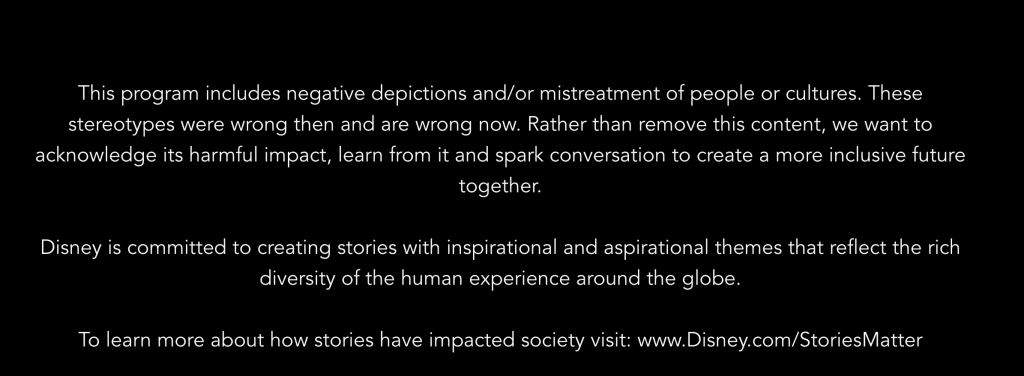
You can find more information about the advisory council and their work towards inclusion HERE.
All that being said, there’s a reason it was the 4th highest grossing film in 1967. Released in December of 1967, the reviews at the time were almost universally effusive. Charles Champlin of the LA Times said, “It is a labor of patient love (nearly four years in the making) as remarkable in its visible man-hours as a wall-sized tapestry and mosaic. It is beautiful to see.” Howard Thompson of The New York Times said, “A perfectly dandy cartoon feature, “The Jungle Book,” scooted into local theaters yesterday just ahead of the big day, and it’s ideal for the children. Based loosely on Rudyard Kipling’s “Mowgli” stories, this glowing little picture should be grand fun for all ages, for in spirit, flavor and superb personification of animals, the old Disney specialty, the new film suggests that bygone Disney masterpiece, “Dumbo.” Life magazine said, “The story men, forgetting all they may have picked up about mythology’s relationship to mankind’s collective unconscious, have given the artists first class low-comedy gag sequences to work on and there are some simple bouncy songs to further enliven the proceedings.” In Time magazine, one reviewer explained its appeal this way: “The reasons for its success lie in Disney’s own unfettered animal spirits, his ability to be childlike without being childish. In his Jungle safari, he obviously aimed for the below-twelve market by stuffing his scenario with pratfalls and puffing it with the kind of primitive tunes that can be whistled through the gap left by a missing front tooth.”
The financial success of The Jungle Book was probably bolstered by a nostalgic remembrance of studio founder Walt Disney, who had died only 6 weeks after a lung cancer diagnosis in December of 1966. Still, it is beloved and appreciated to this day, and had a huge influence on the animators of the New Golden Age of Disney. It is Scar, Afar, and Roger Rabbit animator Andreas Deja’s favorite Disney movie, and Pocahontas director and animator Eric Goldberg, character designer for Aladdin’s Genie, calls the work on the film “possibly the best character animation a studio has ever done”.
Watching The Jungle Book in the last few days to find screen caps for our new production cels and concept art, I am once again drawn to George Sanders. Shere Khan is by no means my favorite character in the movie. That honor is shared by Bagheera and King Louie. Even in animation, Sanders is magnetic, stealing his scenes just as he did in every live action film he was ever in. In his Oscar-winning role as critic Addison DeWitt in All About Eve, he has Marilyn Monroe on his arm, and your eyes still follow Sanders. Speaking as one of his legion of fans, we are indebted to fellow thespian Greer Garson, who had been a secretary working at the same advertising agency as Sanders. She’s the one who suggested he could have a successful acting career. If you love George Sanders as much as I do, you’ll enjoy knowing he also tried his hand at singing and songwriting. Here he is singing a song from his 1958 album The George Sanders Touch: Songs for the Lovely Lady:
I was so excited to get some Jungle Book original production cels that hadn’t been restored and were in good condition! Most production cels from the film were sold as Disneyland mat setups, that is, they were sold at the art corner at Disney back when the movie was released, and so they are all stuck to their backgrounds. It’s inherent to the era. I think no one should restore Jungle Book production cels unless they are so damaged they can’t be enjoyed as they are. This is rarely the case for Disneyland mat setups, so I do wish dealers would just leave them alone. Isn’t it better to have the entirety of the art intact as photographed in the making of the movie? Anyway, here are the Jungle Book production cels we just got in, which, along with the realization that Jungle Book turns 55 this year (!!) inspired this blog:
10 THING YOU MIGHT NOT KNOW ABOUT DISNEY’S THE JUNGLE BOOK
1 – With Shere Khan, George Sanders became the first Academy Award-winning actor to voice a Disney character. He had become friends with Walt after starring in 1962’s In Search of the Castaways, and got the role after Walt saw him in early concept drawings of the character.
2 – The Jungle Book was Verna Felton’s last movie. She died a little less than 2 days before Walt. Playing the elephant matriarch Winifred, Colonel Hathi’s wife, she bookended her experience with Disney studios with elephants, since her first vocal role was the elephant matriarch in Dumbo.
3 – The music for the film’s opening overture was written for the 1964 World’s Fair.
4 – The Jungle Book was rated G by the Motion Picture Association of America. It was the last Disney animated film to include the 1945 MPAA logo, and the last animated Disney film to be released during the Hays Office Code before its elimination in 1968.
5 – The Beatles were supposed to voice the vultures and sing the song That’s What Friends Are For”, but John Lennon refused. Lennon was quoted as saying: “There’s no way The Beatles are gonna sing for Mickey f*cking Mouse. You can tell Walt Disney to f*ck off. Tell him to get Elvis off his fat arse, he’s into making crap f*cking movies.” Tell us how you really feel, John!
6 – Gregory Peck, the president of the Academy at the time, lobbied heavily for The Jungle Book to be nominated for Best Picture, as well as the inclusion of animated features for consideration in Best Picture nominations. It didn’t happen, and he resigned over it. (Go Gregory!)
7 – Legendary story artist Bill Peet was originally the one who suggested The Jungle Book to Walt as an animated feature. Peet actually created the character of King Louie, who wasn’t in the original stories. His version of the story followed the dark tone of Kipling’s book. Walt insisted on script changes, and Peet refused. Dramatic and intense arguing ensued, leading to Peet quitting Disney altogether in January 1964.
8 – The Bare Necessities, the only song in the movie not written by The Sherman Brothers, was nominated for an Oscar, but lost to “Talk to the Animals” from Doctor Doolittle, “sung” (or spoken, really) by Rex Harrison. Rex Harrison never did voice acting, but Friz Freleng tried to hire him to voice Pink Panther. He demured, and Rich Little was hired to do an impression of him for two cartoons, 1965’s Sink Pink and Pink Ice.
9 – Louis Armstrong was the first choice to voice King Louie. Phil Harris, the voice of Baloo, improvised most of his lines. All the scatting by both Harris and Louis Prima was entirely improvised during recording sessions.
10 – The wolf cubs in The Jungle Book are all based on the puppies from 101 Dalmatians.


